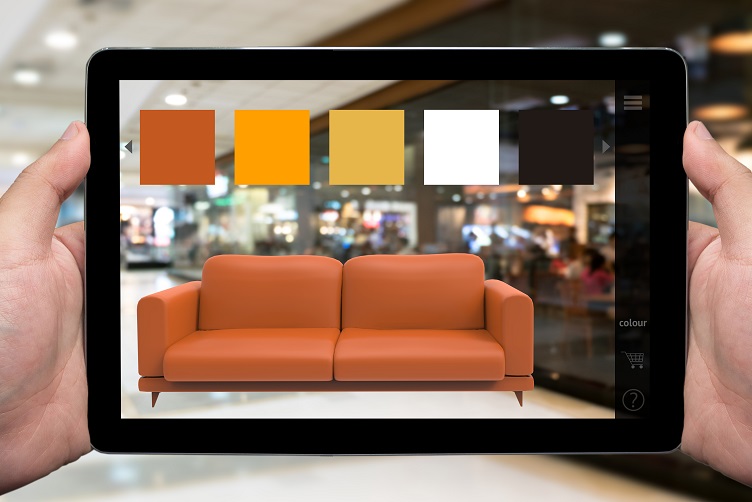The retail shopping sector is the most active and competitive market which literally pursuers creative and inventive ways that are considered not only as a USP to the customers but also a tool to upgrade their business. The aspect of Augmented Reality technology (AR) is a newly emerging trend in the process of consumers’ purchasing activities.
AR can be a revolutionary tool for shops and regular retail as it can create better interaction with customers, entirely change the shopping process, and positively influence sales. AR involves overlaying on the physical world of technical information, creating a mixed reality. Using this blog post, we have revealed the use of AR in retail with the shopping industry.
Application of Augmented Reality in the Retail Shopping Industry
The application of AR in retail shopping has transformed the way consumers interact with products and brands. In the under section, we have mentioned the applications of augmented reality in the retail shopping industry:
Enhanced In-Store Experiences
Stores have been given new life by augmented reality, which has made them more dynamic and engaging. Retailers can employ augmented reality (AR) to give customers immersive experiences, like interactive product displays, virtual fitting rooms, and in-store navigation.
Product Visualization
One of the primary benefits of AR in retail is its ability to help consumers visualize products more effectively. Retailers of furniture, for instance, may provide augmented reality apps that let users position virtual furniture in their homes to see how it fits and looks. This lowers the possibility of returns while also helping clients make better purchases.

Personalization
AR technology will be capturing customer preferences and shopping data to tailor recommendations and content to individuals. Using data from users’ previous purchases and browsing history, retailers can personalize in-store experiences that fit the individual’s requirements and match their tastes. This will offer a unique and more tailored personal experience that in most cases leads to increased customer loyalty and satisfaction.
Virtual Try-Ons
The fashion and beauty sectors use AR by offering consumers an opportunity for virtual boutiques, lipstick tests, or trying on virtual clothes at home. Previously, customers had to purchase an accessory, makeup, or apparel to see how they would look, now they can virtually try things on without buying anything. In the same way, this will ensure a good shopping experience for the customer and will also make the returns fewer, thus saving the customer and business time and money.
Product Information
AR may be adapted to the purpose of educating consumers with information on products in detail. People can simply take a look at this product’s characteristics and review it with its barcode or photo by scanning it. It ensures that buyers are supplied with whatever they may require to make what really counts.
Interactive Displays
Retailers can use AR to create interactive displays in-store. For instance, AR stations in children’s toy stores allow kids to engage with virtual characters or observe how products function in a virtual setting. This draws clients in and keeps them interested and delighted.
Navigation and Wayfinding
Large retail stores or shopping centers can benefit from AR-powered navigation and wayfinding apps. These apps help customers find their way around the store, locate specific products, and receive personalized promotions based on their location within the store.
Augmented Shopping Lists
AR apps can help customers create and manage shopping lists more efficiently. By scanning items at home or in-store, the app can keep track of the products needed and provide reminders or suggestions. This simplifies the shopping process and reduces the likelihood of forgetting essential items.

Virtual Window Shopping
Some retailers are in the practice of AR the “virtual storefront” creation. When one walks by the store, with their smartphone or AR smart glasses. They may seem to see and order products that are on display when the store is closed. This supports increased shopping hours and makes retail shops conceivable 24 hours a day, i.e., around the clock.
Impact on Retail Businesses
The integration of AR into the retail shopping experience has a profound impact on businesses in this industry. The integration of AR into the retail shopping experience has a profound impact on businesses in this industry:
Increased Sales
AR technology could be a key to moving the consumer to the inappropriate purchase along with extra upsell or added product feature options. Industrial case would be like a customer who buys a pair of shoes via an AR app would be able to coordinate the outfit by the app as well such as provision of matching accessories or related products, maximizing the value of the overall purchase.
Reduced Returns
As discussed previously, buyers will be able to obtain more accurate information with the assistance of AR. When partners are more sure they will have a better look and fit in the actual space they will have fewer it-returns which means a saving for the retailers on the costs they would have been on because of it-returns.
Improved Customer Engagement
AR enables customers to explore and experiment with various goods. They get involved in the process of shopping thus keeping them constantly interested. This will contribute to higher customer loyalty and will lead to regular clientele.

Data Collection and Personalization
Retailers can collect valuable data on customer preferences and behavior through AR applications. This data can be used to tailor marketing efforts, make product recommendations, and provide a more personalized shopping experience.
Competitive Advantage
Early adopters of AR in the retail industry gain a competitive advantage. Being innovative and offering unique experiences can attract new customers and set businesses apart from their competitors.
Challenges and Considerations
While AR presents significant opportunities, retailers must also address several challenges and considerations:
- Developing AR applications and infrastructure can be expensive.
- Customers must have access to the necessary technology, such as smartphones or AR glasses, to fully experience AR applications. This can limit the reach of AR initiatives.
- Collecting customer data through AR applications must be done responsibly and securely.
- The success of AR applications depends on the quality of the content and user experience.
- Retail staff and customers need to be educated about how to use AR applications. To guarantee a seamless transition, retailers had to make training investments.
Conclusion
The fact that retailers are using augmented reality to serve their customers now is much more than just the visibility of the development. It shows the fundamental change in the way that customers interact with the products of retailers and their services. Retailers can create a shopping atmosphere that will boost sales over time. This makes the customers addicted to the store that has implemented augmented reality (AR).
In the future, AR technology will keep advancing so more and more businesses can take advantage of it. For retailers, it is necessary to take advantage of the promised capacity of AR. They should face the challenges and key items that accompany incorporating it. If they want to dominate in this competitive arena. Without any doubt, we can expect the evolution of the shopping experience of the future to include e-commerce with VR, storytelling, virtual assistants, as well as biometrics.

